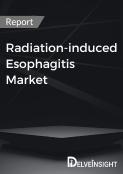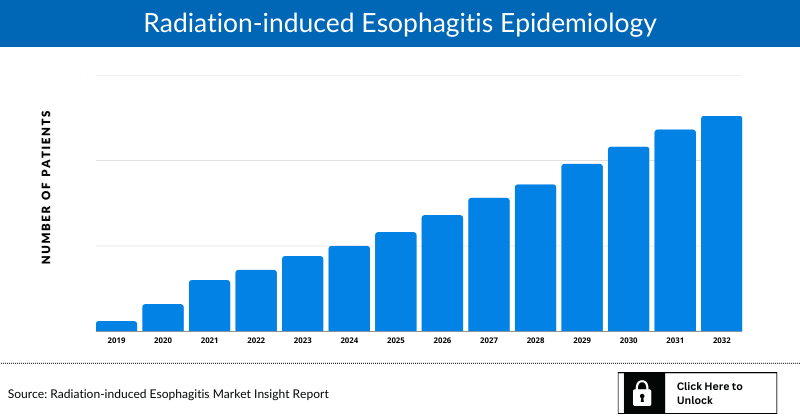Radiation-induced Esophagitis Market
- The Radiation-induced Esophagitis Market is expected to strengthen as awareness of the disease increases and more effective interventions are being developed.
- The leading Radiation Induced Esophagitis Companies such as Galera Therapeutics Inc., MEDA Pharma GmbH & Co. KG, Trium Analysis Online GmbH, ICON PLC, and others.
Request for unlocking the CAGR of the Radiation-induced Esophagitis Treatment Market
DelveInsight's "Radiation-induced Esophagitis Market Insights, Epidemiology, and Market Forecast-2032" report delivers an in-depth understanding of the Radiation-induced Esophagitis, historical and forecasted epidemiology as well as the Radiation-induced Esophagitis market trends in the United States, EU5 (Germany, Spain, Italy, France, and United Kingdom) and Japan.
The Radiation-induced Esophagitis Treatment Market Report provides current treatment practices, emerging drugs, the Radiation-induced Esophagitis market share of the individual therapies, and current and forecasted Radiation-induced Esophagitis market Size from 2019 to 2032, segmented by seven major markets. The report also covers the current Radiation-induced Esophagitis treatment market, Radiation-induced Esophagitis market drivers and market barriers, and Radiation-induced Esophagitis unmet needs to curate the best of the opportunities and assess the underlying potential of the Radiation-induced Esophagitis market.
|
Study Period |
2019 to 2032 |
|
Forecast Period |
2023-2032 |
|
Geographies Covered |
|
|
Radiation-induced Esophagitis Market |
|
|
Radiation-induced Esophagitis Market Size | |
|
Radiation-induced Esophagitis Companies |
|
Radiation-induced Esophagitis Treatment Market
The Radiation-induced Esophagitis treatment market refers to the sector within the healthcare industry dedicated to developing and providing effective solutions for individuals suffering from esophagitis due to radiation therapy. Esophagitis, characterized by inflammation of the esophagus, is a common side effect of radiation treatment for various cancers. This market focuses on the research, development, and commercialization of therapies and medications aimed at alleviating the symptoms and improving the quality of life for patients undergoing radiation therapy. DelveInsight’s Radiation-induced Esophagitis market report gives a thorough understanding of Radiation-induced Esophagitis by including details such as disease definition, symptoms, causes, pathophysiology, diagnosis, and treatment.
Radiation-induced esophagitis is a consequence of radiotherapy toxicity over the esophagus resulting in both acute and chronic complications. It is an aseptic inflammation of esophageal mucosa. The radiation mainly causes the esophageal mucosal injury. The main effector cells are monocytes and macrophages, which are over-activated in response to radiation stimulation and release a large number of inflammatory mediators, such as IL-6, IL-10 and TNF-α, leading to pathological damage.
Radiation-induced Esophagitis Diagnosis
This segment of the report covers the detailed diagnostic methods or tests for Radiation-induced Esophagitis.
Radiation-induced Esophagitis Treatment
Radiation-induced esophagitis, a common side effect of radiation therapy for thoracic cancers, refers to the inflammation of the esophagus caused by radiation exposure. Managing this condition is essential to ensure the patient's comfort and overall well-being during cancer treatment. Treatment strategies focus on alleviating symptoms and promoting healing of the affected esophageal tissue. Patients often receive medications such as proton pump inhibitors to reduce stomach acid and minimize irritation. It covers the details of conventional and current medical therapies available in the Radiation-induced Esophagitis market for the treatment of the condition. It also provides Radiation-induced Esophagitis treatment algorithms and guidelines in the United States, Europe, and Japan.
Radiation-induced Esophagitis Epidemiology
The Radiation-induced Esophagitis epidemiology section provides insights into the historical and current Radiation-induced Esophagitis patient pool and forecasted trends for individual seven major countries. It helps to recognize the causes of current and forecasted trends by exploring numerous studies and views of key opinion leaders. This part of the Radiation-induced Esophagitis market report also provides the diagnosed patient pool and their trends along with assumptions undertaken.
Key Findings
The Radiation-induced Esophagitis epidemiology covered in the report provides historical as well as forecasted Radiation-induced Esophagitis epidemiology scenario in the 7MM covering the United States, EU5 countries (Germany, Spain, Italy, France, and the United Kingdom), and Japan from 2019 to 2032.
Country Wise- Radiation-induced Esophagitis Epidemiology
The Radiation-induced Esophagitis epidemiology segment also provides the Radiation-induced Esophagitis Prevalence Data and findings across the United States, EU5 (Germany, France, Italy, Spain, and the United Kingdom), and Japan.
Radiation-induced Esophagitis Drugs Market Chapters
The drug chapter segment of the Radiation-induced Esophagitis drugs market report encloses a detailed analysis of Radiation-induced Esophagitis marketed drugs and late-stage (Phase-III and Phase-II) Radiation-induced Esophagitis pipeline drugs analysis. It also helps to understand the Radiation-induced Esophagitis Clinical Trials details, expressive pharmacological action, agreements and collaborations, approval and patent details, advantages and disadvantages of each included drug, and the latest news and press releases.
Radiation-induced Esophagitis Marketed Drugs
The Radiation-induced Esophagitis Therapeutics Market Report provides the details of the marketed products/off-label treatments available for Radiation-induced Esophagitis treatment.
Radiation-induced Esophagitis Emerging Drugs
The Radiation-induced Esophagitis Therapeutics Market Report provides the details of the emerging therapies under the late and mid-stage of development for Radiation-induced Esophagitis treatment.
Radiation-induced Esophagitis Market Outlook
The Radiation-induced Esophagitis market outlook of the report helps to build a detailed comprehension of the historic, current, and forecasted Radiation-induced Esophagitis market trends by analyzing the impact of current Radiation-induced Esophagitis therapies on the market, Radiation-induced Esophagitis unmet needs, Radiation-induced Esophagitis market drivers and barriers, and demand for better technology.
This segment gives a thorough detail of Radiation-induced Esophagitis market trend of each marketed drug and late-stage pipeline therapy by evaluating their impact based on the annual cost of therapy, inclusion and exclusion criteria's, mechanism of action, compliance rate, growing need of the market, increasing patient pool, covered patient segment, expected launch year, competition with other therapies, brand value, their impact on the market and view of the key opinion leaders. The calculated Radiation-induced Esophagitis market outlook data are presented with relevant tables and graphs to give a clear view of the market at first sight.
"According to DelveInsight, the Radiation Induced Esophagitis Treatment Market Size in 7MM is expected to witness a major change in the study period 2019-2032"
Key Findings
This section includes a glimpse of the Radiation-induced Esophagitis Therapeutics Market in 7MM.
The United States: Radiation-induced Esophagitis Market Outlook
This section provides the total Radiation-induced Esophagitis treatment market size and market size by therapies in the United States.
EU-5 Countries: Radiation-induced Esophagitis Market Outlook
The total Radiation-induced Esophagitis market size and market size by therapies in Germany, France, Italy, Spain, and the United Kingdom is provided in this section.
Japan: Radiation-induced Esophagitis Market Outlook
The total Radiation-induced Esophagitis treatment market size and market size by therapies in Japan is also mentioned.
Radiation-induced Esophagitis Drugs Uptake
This section focuses on the rate of uptake of the potential Radiation-induced Esophagitis drugs recently launched in the Radiation-induced Esophagitis market or expected to get launched in the market during the study period 2019-2032. The analysis covers Radiation-induced Esophagitis market uptake by drugs; patient uptake by therapies; and sales of each drug. Radiation-induced Esophagitis Drugs Uptake helps in understanding the drugs with the most rapid uptake, and reasons behind the maximal use of new Radiation-induced Esophagitis drugs, and allow the comparison of the drugs on the basis of Radiation-induced Esophagitis market share and size which again will be useful in investigating factors important in market uptake and in making financial and regulatory decisions.
Radiation-induced Esophagitis Pipeline Development Activities
The Radiation-induced Esophagitis pipeline segment provides insights into different therapeutic candidates in Phase II, and Phase III stage. It also analyses Radiation-induced Esophagitis key players involved in developing targeted therapeutics.
Pipeline Development Activities
The Radiation-induced Esophagitis pipeline segment covers the detailed information of collaborations, acquisition, and merger, licensing, patent details, and other information for Radiation-induced Esophagitis emerging therapies.
Reimbursement Scenario
Approaching reimbursement proactively can have a positive impact both during the late stages of product development and well after product launch. In a Radiation Induced Esophagitis Treatment Market report, we take reimbursement into consideration to identify economically attractive indications and market opportunities. When working with finite resources, the ability to select the markets with the fewest reimbursement barriers can be a critical business and price strategy.
KOL- Views
To keep up with current Radiation-induced Esophagitis market trends, we take KOLs and SMEs ' opinion working in the Radiation-induced Esophagitis domain through primary research to fill the data gaps and validate our secondary research. Their opinion helps to understand and validate current and emerging therapies treatment patterns or Radiation-induced Esophagitis market trends. This will support the clients in potential upcoming novel treatment by identifying the overall scenario of the market and the unmet needs.
Competitive Intelligence Analysis
We perform Competitive and Market Intelligence analysis of the Radiation-induced Esophagitis Market by using various Competitive Intelligence tools that include - SWOT analysis, PESTLE analysis, Porter's five forces, BCG Matrix, Market entry strategies etc. The inclusion of the analysis entirely depends upon the data availability.
Radiation-induced Esophagitis Therapeutics Market Report Scope
- The Radiation Induced Esophagitis Treatment Market report covers the descriptive overview of Radiation-induced Esophagitis, explaining its causes, signs and symptoms, pathophysiology, diagnosis and currently available therapies
- Comprehensive insight has been provided into the Radiation-induced Esophagitis epidemiology and treatment in the 7MM
- Additionally, an all-inclusive account of both the current and emerging therapies for Radiation-induced Esophagitis is provided, along with the assessment of new therapies, which will have an impact on the current treatment landscape
- A detailed review of the Radiation-induced Esophagitis market; historical and forecasted is included in the report, covering drug outreach in the 7MM
- The Patient-Based Radiation-Induced Esophagitis Market Forecasting report provides an edge while developing business strategies, by understanding trends shaping and driving the global Radiation-induced Esophagitis drugs market
Radiation Induced Esophagitis Therapeutics Market Report Highlights
- In the coming years, the Radiation-induced Esophagitis Therapeutics Market is set to change due to the rising awareness of the disease, and incremental healthcare spending across the world; which would expand the size of the market to enable the drug manufacturers to penetrate more into the market
- The Radiation-induced Esophagitis companies and academics are working to assess challenges and seek opportunities that could influence Radiation-induced Esophagitis R&D. The Radiation-induced Esophagitis therapies under development are focused on novel approaches to treat/improve the disease condition
- Radiation-induced Esophagitis Companies are involved in developing therapies for Radiation-induced Esophagitis. The launch of emerging therapies will significantly impact the Radiation-induced Esophagitis Drugs Market
- A better understanding of disease pathogenesis will also contribute to the development of novel therapeutics for Radiation-induced Esophagitis
- Our in-depth analysis of the pipeline assets across different stages of development (Phase III and Phase II), different emerging trends and comparative analysis of pipeline products with detailed Radiation-Induced Esophagitis Clinical Trials profiles, key cross-competition, launch date along with product development activities will support the clients in the decision-making process regarding their therapeutic portfolio by identifying the overall scenario of the research and development activities
Radiation-induced Esophagitis Therapeutics Market Report Insights
- Patient-Based Radiation-Induced Esophagitis Market Forecasting
- Therapeutic Approaches
- Radiation-induced Esophagitis Pipeline Drugs Analysis
- Radiation-induced Esophagitis Market Size
- Radiation-induced Esophagitis Market Trends
- Radiation-induced Esophagitis Drugs Market Opportunities
- Impact of Upcoming Radiation-induced Esophagitis Therapies
Radiation-induced Esophagitis Therapeutics Market Report Key Strengths
- 10 Years Radiation-induced Esophagitis Market Forecast
- 7MM Coverage
- Radiation-induced Esophagitis Epidemiology Segmentation
- Key Cross Competition
- Highly Analyzed Radiation Induced Esophagitis Drugs Market
- Radiation-induced Esophagitis Pipeline Drugs Uptake
Radiation-induced Esophagitis Treatment Market Report Assessment
- Current Radiation-induced Esophagitis Treatment Market Practices
- Radiation-induced Esophagitis Unmet Needs
- Radiation-induced Esophagitis Pipeline Drugs Profiles
- Radiation-induced Esophagitis Market Attractiveness
- Radiation-induced Esophagitis Market Drivers
- Radiation-induced Esophagitis Market Barriers
Key Questions
Radiation-induced Esophagitis Treatment Market Insights:
- What was the Radiation-induced Esophagitis drugs market share (%) distribution in 2019 and how it would look like in 2032?
- What would be the Radiation-induced Esophagitis treamtent market size as well as market size by therapies across the 7MM during the forecast period (2023-2032)?
- What are the key findings pertaining to the market across 7MM and which country will have the largest Radiation-induced Esophagitis market size during the forecast period (2023-2032)?
- At what CAGR, the Radiation-induced Esophagitis market is expected to grow by 7MM during the forecast period (2023-2032)?
- What would be the Radiation-induced Esophagitis market outlook across the 7MM during the forecast period (2023-2032)?
- What would be the Radiation-induced Esophagitis market growth till 2032, and what will be the resultant market Size in the year 2032?
- How would the unmet needs affect the market dynamics and subsequent analysis of the associated trends?
Radiation-induced Esophagitis Epidemiology Insights:
- What are the disease risk, burden, and regional/ethnic differences of the Radiation-induced Esophagitis?
- What are the key factors driving the epidemiology trend for seven major markets covering the United States, EU5 (Germany, Spain, France, Italy, UK), and Japan?
- What is the historical Radiation-induced Esophagitis patient pool in seven major markets covering the United States, EU5 (Germany, Spain, France, Italy, UK), and Japan?
- What would be the forecasted patient pool of Radiation-induced Esophagitis in seven major markets covering the United States, EU5 (Germany, Spain, France, Italy, UK), and Japan?
- Where will be the growth opportunities in the 7MM with respect to the patient population pertaining to Radiation-induced Esophagitis?
- Out of all 7MM countries, which country would have the highest prevalent population of Radiation-induced Esophagitis during the forecast period (2023-2032)?
- At what CAGR the patient population is expected to grow in 7MM during the forecast period (2023-2032)?
Current Radiation-induced Esophagitis Treatment Market Scenario, Marketed Drugs and Emerging Therapies:
- What are the current options for the Radiation-induced Esophagitis treatment in addition to the approved Radiation-Induced Esophagitis Therapies?
- What are the current treatment guidelines for the treatment of Radiation-induced Esophagitis in the USA, Europe, and Japan?
- What are the Radiation-induced Esophagitis marketed drugs and their respective Radiation-Induced Esophagitis MOA, regulatory milestones, product development activities, advantages, disadvantages, safety and efficacy, etc.?
- How many companies are developing therapies for the treatment of Radiation-induced Esophagitis?
- How many therapies are in-development by each company for Radiation-induced Esophagitis treatment?
- How many are emerging therapies in mid-stage, and late stage of development for Radiation-induced Esophagitis treatment?
- What are the key collaborations (Industry - Industry, Industry - Academia), Mergers and acquisitions, licensing activities related to the Radiation-induced Esophagitis therapies?
- What are the recent novel therapies, targets, Radiation-Induced Esophagitis mechanisms of action and technologies being developed to overcome the limitations of existing therapies?
- What are the Radiation-Induced Esophagitis Clinical Trials Studies going on and their status?
- What are the current challenges faced in drug development?
- What are the key designations that have been granted for the emerging Radiation-Induced Esophagitis therapies?
- What are the global historical and Radiation-induced Esophagitis Market Forecast?
Reasons to Buy
- The patient-based Radiation-induced Esophagitis market forecasting report will help in developing business strategies by understanding trends shaping and driving the Radiation-induced Esophagitis market
- To understand the future market competition in the Radiation-induced Esophagitis Drugs Market and Insightful review of the key Radiation-induced Esophagitis market drivers and barriers.
- Organize sales and marketing efforts by identifying the best opportunities for Radiation-induced Esophagitis in the US, Europe (Germany, Spain, Italy, France, and the United Kingdom) and Japan
- Identification of strong upcoming players in the market will help in devising strategies that will help in getting ahead of competitors
- Organize sales and marketing efforts by identifying the best opportunities for Radiation-induced Esophagitis Drugs Market
- To understand the future market competition in the Radiation-induced Esophagitis Drugs Market
Stay updated with us for Recent Articles @ Latest DelveInsight Blogs




